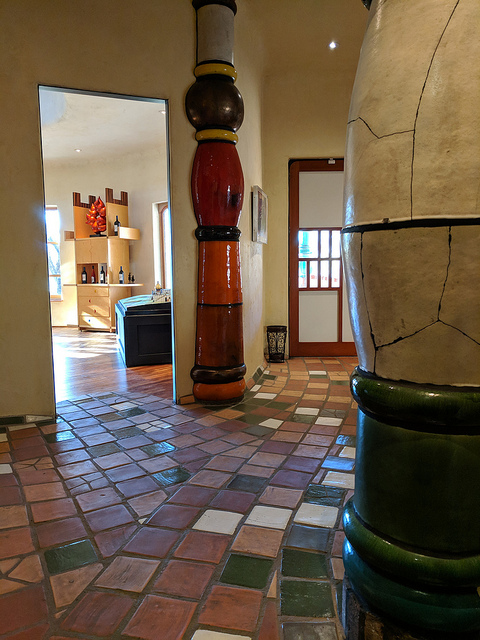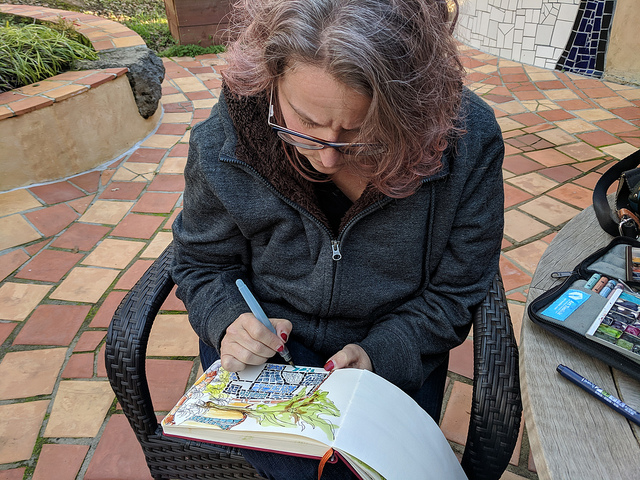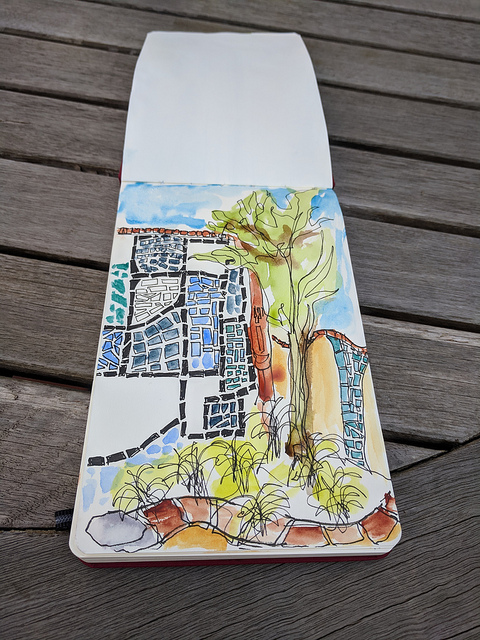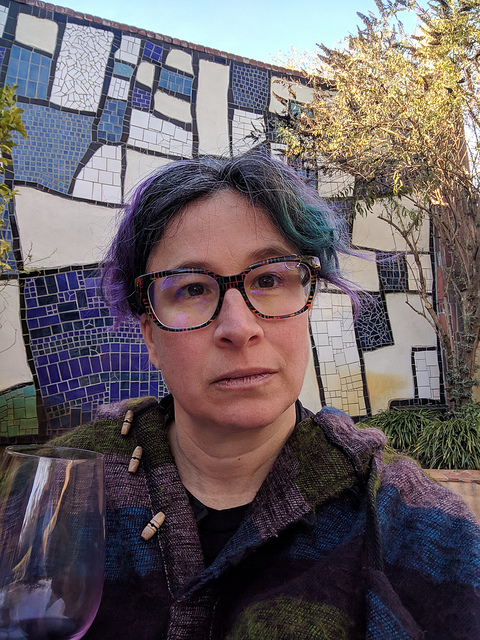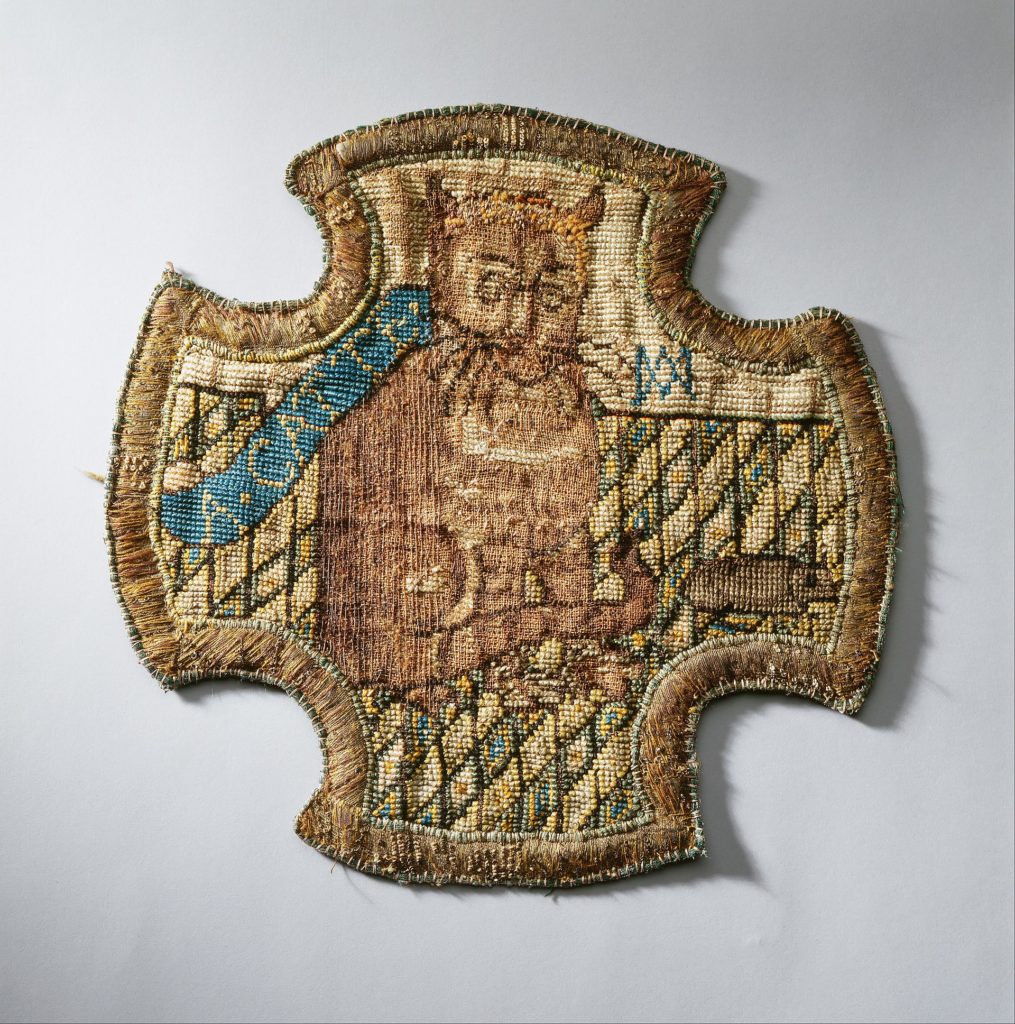24th St Mission BART station report
Starting my BART station report series with my home station, 24th St Mission. Sometimes the St is spelled out so it’s 24th Street Mission, and sometimes it’s abbreviated in station signs. You can get some overview of the neighborhood on the Calle 24 Historic District site in English and Spanish. Get ready to ramble! I’m going to just write everything that comes into my mind from my notes, memories, and researches. I hope that you will enjoy reading it and then will see this (or some other train station or place in your city) with a new perspective.
Though I can go the half mile from my house to the station under my own power, this time I got there on the bus, debouching directly in front of a bench where a guy with a 49ers jacket was sitting holding a bug-eyed chihuahua on his lap, passing by him to scoot into Taqueria El Farolito since the line was very short.
El Farolito has a narrow corridor along the kitchen where you order and wait, and small picnic tables along the wall. I can make it in there in my powerchair to order, turn around by the jukebox after I order, and make it back out, but there is nowhere my wheelchair can fit for me to sit and eat inside. No big deal. As is usual in SF taquerias you get a number and lurk around the counter listening for your number. Bonus if you understand numbers in Spanish. I got a carnitas super burrito with everything and a mexican coke to go, which comes with a little bag of chips and some napkins, in a plastic bag with handles. The handles are so useful and important for hanging the bag on the arm of my wheelchair. Mexican coke is nicer and tastier than US coke because it uses cane syrup instead of corn syrup and it comes in a pretty glass bottle.
If you can see over the counter as you wait (I cannot in this particular location) then please admire the efficiency of the burrito-makers and study their workflow. It is instructive to compare the workflow of different taquerias, for stunning speed, La Taqueria; for complexity (sometimes as many as 14 people behind the narrow counter) Pancho Villa. Keep in mind that THESE BURRITOS ARE LOVE. You are going to be nurtured by your delicious and amazing burrito. Appreciate it properly.
At some point over the years I wondered what possible connection there was between burritos and lighthouses (Faro = lighthouse in Spanish and in many romance languages from the famous Lighthouse of Alexandria on the island of Pharos). I think it is from the “home of the Mission burrito” being Febronio Ontiveros‘ El Faro taqueria. So maybe El Farolito is an offshoot of the original El Faro at 20th and Folsom.
As I was waiting two mariachis came in, one with accordion, another with guitar and an amp on a hand truck. They set up and started playing in the back of the tiny narrow restaurant. I got my own salsa in containers and headed out to eat in the BART plaza. I shared one of the square cement bench blocks with a friendly tamale lady and a couple who were discussing their plans for the day in Spanish; staying in my comfy powerchair but using the bench corner for my coke bottle and bag of chips and also putting my feet up on there from time to time. One bench over, I noticed the Raccoon Guy (a white haired and bearded grizzled older man who has hung out in this plaza for years but recently achieved viral fame for bringing a dead raccoon into the nearby McDonald‘s.) From this we can deduce that 24th and Mission is a pretty good raccoon habitat, barring accidents.
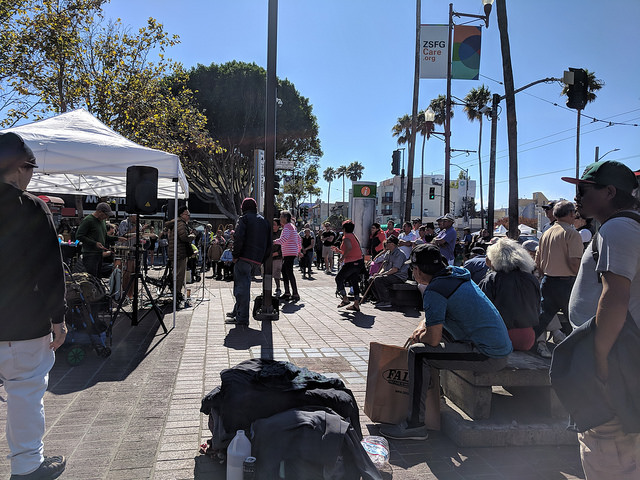
OK so this plaza, the one on the Northeast corner. I am pretty familiar with it and it is one of my favorite hangouts, sort of refreshing and beautiful to me in a special way. Yes I realize sometimes it smells like pee. Try to bear with me. When it doesn’t smell too much like pee, it’s so nice! Lively, full of action, so much to look at, excellent food for the flaneur’s soul! On weekends there are often loud preachers or a band of old dudes playing mostly Cuban music. If I get there for the music then I hang out for a few songs and put some money in their donation bin. It is a lovely scene on a sunny day with families stopping to watch, people dancing, the tall washingtonia palms far overhead against a blue sky. Even without those very organized musicians, there are frequently other musicians playing in the plaza or coming up from the BART stairwell, and music coming from someone’s portable speaker or cars or the market in the southwest plaza that’s catty-corner across the street. The buses fwoosh and beep, the distinctive train car sound swells up from underground, Norteño or salsa music comes and goes, lots of Spanish and Chinese spoken all around. It is a lively soundscape that I absolutely love.
Facing north from this plaza, you’ll see a mural on the wall of El Farolito. This is by Michael V. Rios and shows a geometric cityscape, and some determined, rather grim people shouldering train rails with a shining metal BART train riding on top. It has a nice socialist realist feel to it, as it honors the workers who built and maintain the city’s infrastructure. The gleaming futuristic train is carried on the backs of the people! Maybe the people who built it or the people who paid for it with their taxes!
Facing west, past the stairwell, there is a giant mural on the side of the Silverstone cafe in addition to the super funky and cool coffee and tea sign of Silverstone. Sorry I don’t know much about the mural and forgot to take pictures but it says something like “SOCKS” on it. More later if I go investigate, or find info about this mural online. The Silverstone Cafe itself is quite nice, and has wifi and – I didn’t know till this week’s exploration – A pretty nice patio in back! And good, low priced, (large) pastries and breakfast and sandwich type of food. The interior is beautiful with a giant wooden… bar back or mantelpiece sort of thing. Because of the TV I didn’t try to work from this cafe, though I might in future. (Instead I ended up a few blocks down 24th, at Haus, which also has a lovely patio and an accessible bathroom.) If you go that direction you could also stop by Precita Eyes and learn more about the neighborhood’s murals.
I didn’t hang out today at the southwest plaza but can say it has a pleasant street market with booth selling jewelry, souvenirs, shopping bags, belts, phone cases and chargers, headphones, shirts (often ones embroidered huipil style) and ponchos (wool). There are also sometimes flower sellers and a booth for vitamin type of things, phone plan sales. Sometimes events in the far corner under the Coffee & Mission mural like, breakdancers or rappers. This mural is on Osage St. and is by Mark Bode, Mel Waters, Dino, Nite Owl, Dagon, and Free. You may notice Mel Waters‘ distinctive style in like, a zillion other murals all over the Misson and the rest of the Bay Area. There is a big metal ventilation tower here that, in Ingress and Pokémon, is a portal named Lipstick Tube after the shape of the tower. The way the plaza is shaped in the back by the stairwell entrance makes a pretty good stage for any sort of street events. There is also a dark green kiosk-style public bathroom in this plaza. I have never used it, opting to buy a coffee or something instead to use a bathroom!
Did you ever notice the “two totemic posts” of this plaza? I hadn’t. Hang onto your hats as I want to paste in a hefty quote from the designers.
The two totemic posts in the foreground were placed to formalize a stage area already used as such by the community. Otherwise, most vertical elements were removed to open up the plaza.
The plaza was originally designed along with the underground station in 1970. The basic configuration is an open plaza paved in a concentric brick pattern that radiates out from a large circular opening in the center. The opening comprises the main station entrance, containing a stair and escalator column with recessed semicircular planters on either side.
The circular opening offered the design team a powerful theme. The circle form not only ties together design elements throughout the plaza but attempt to also communicate universal notions. The circle is an ancient form used by many civilizations. It was universal and almost always represented the sun and thence fecundity, society and important values.
Eliminating the security fencing revealed the existing great circle—being able to enter and emerge from such a shape is an unusual experience even in a famous city. The cylindrical tower (necessary to protect the existing spiral stair) acts as a beacon for the station and recalls an ancient Maya astronomical observatory. It has a south-facing skylight through which the sun illuminates colored portholes. Emerging from the circle passengers will catch a glimpse of colored sunlight—but the light will not again appear in the same spot for an entire year. Of identical shape to the tower are shiny bollards (necessary to prevent vehicle intrusion from the alley) that are positioned in various angles to reflect sunlight at different strengths when seen from a distance. Throughout the plaza can be found variations on the theme of circles, light and totems.
Nifty! (What spiral stair?! Is that what the Lipstick Tube is?! I assumed it was for ventilation!)
Back to our BART station. I did not get even halfway through the burrito. I can live off a burrito for like, three meals at LEAST. While I was sitting there a mad-eyed disheveled dude asked me and everyone nearby for change. He eventually settled down elsewhere in the plaza. Being accosted for money is likely but just take it in stride. If you like to help people you might keep some dollar bills in a pocket ready to dole out (that’s what I do) and know how to set limits on the interaction, and how to say no. It may make you uncomfortable though especially at night. Personally I feel perfectly comfortable here day and night as it is very public and well lit with tons of people around. Anyway, I sat through many buses pulling up, people walking by, tamale lady calling out her wares (tamales de pollo, de carne!) and selling some from her ice chest on wheels. She’s super nice, I see her there a lot.
I waited for the elevator with a sweet family who had been shopping (grandma, mom, and teenage daughter with her backpack worn frontways across her stomach). Three dudes were just nearby playing very loud Cuban music (excellent taste) and cat calling us (Ay mamacita!!! que estás bonitaaaaaaaa!!!!) But not like hostile cat calling, basically a . . . non-hostile routine social interaction. I looked over at them and nodded, breaking all the rules of such things, being a sucker for good music and since their piropos weren’t gross or anything. But me and the older women also side-eyed each other in mixed annoyance and amusement and then when we got in the elevator kind of burst out laughing.
The elevator had the horrible smell of pee and industrial cleaning fluid. I always kind of long to tackle the gross walls of this elevator where someone tried to write, or paint, and then it was ineptly and incompletely sprayed with cleaner, so there are horrible drips going down the wall and it looks filthier than if they had just left the graffiti alone. There are also times when there’s… food smeared on the wall? I dunno! The thing with the smell is, the pee must run down through the mechanism of the door to the elevator well below, and just fester there for years. There need to be more bathrooms, open all hours, though, I think the Pit Stop bathrooms do help and in recent years the stench has been ameliorated to some extent.
The elevator from the northeast plaza lets you out in a sketchy feeling nook in the north corner of the concourse. The stairwell there (and, same on the other side) has 2 stairways and an escalator, with abstract concrete bas reliefs by the English sculptor William George Mitchell. If you get up close to the walls you can feel the rough (even sharp) corrugations which are the background to the broad smooth planes of the cement geometric shapes. I wonder if they give the Mission stairwells some of their nice acoustic properties. There are often musicians in them, and while I explored on this day there was an excellent guitarist, Ángel Rodriguez from Banda Sin Nombre, in one stairwell and then later in the day, a saxophonist in the other.
The concourse has a beautiful arched design that makes me think of 70s futuristic things, or maybe particular airports, with the concrete arches overhead soaring like an airplane hangar, and more interesting corrugation in between creating a fairly beautiful line. If you don’t look up, or look at the shape of the buttresses of the arches, you are missing out. The lighting is also really not bad for an underground area. If you do have a look at the ceilings you may also notice a lot of anti-pigeon spikes. (Ow!) Speaking of ow, as a small accessibility note I would say there is an archway pillar between the north stairwell and the entry ticket points where, the slope of it as you might be coming out of the ticket area is such that for a blind cane user, it would be easy to run your head right into the underhang of the arch. Same goes for the pillar by the southwest stairwell as you come out of the ticket area there and turn right – headbonking opportunity. That could be prevented by a small guard rail in both areas.
There’s a ticket entrance by the elevator and the northeast stairwell, and another on the south side of the station, by the agent booth. This south entrance is where the wheelchair and stroller accessible entry and exit point is. In some other stations, the elevator to the platform is outside the pay entry cage so you have to specially remember to reach over the barrier to tag yourself out (even though you’re already out!) Once you’re in the paid area, there are 3 stairwells from south to north; the first is an escalator coming up from the platform, and some bike racks. At the far north end of the paid area you’ll find the elevator to the platform (call button on the left). Like most elevators in the system this one has buttons marked C for Concourse and P for platform.
Platform 1 has the northbound trains, Platform 2 has the southbound. If you traverse the length of the platform you will see the 3 stairwells; the furthest one from the elevator is the escalator going up. In between the escalator and the middle stairwell are some big block style cement benches, and between the second stairwell and the 3rd, there’s a big map and schedule. The median walls (on the stairwells) are tiled with brown, orange, gold, yellow tiles with an occasional black one, which I think of as a kind of nice Painted Desert effect or like the backgrounds for Wile E. Coyote and the Roadrunner. There are mysterious little rooms in these areas too with numbered doors (as there also are on the concourse). I expect these will factor into my BART text adventure game in some way. On the walls to either side of the platform tunnel you can see the same buttress looking cement things as you see above in the concourse. Between those, there’s plain beige tiles and a space for ads.
So, I’m going to return to my game-writing now! This isn’t an exhaustive Guide To Things To Do near 24th and Mission station, though, I do recommend you get a great burrito and admire the murals while you’re here. There is also excellent grocery shopping at many small latin american stores, a middle eastern grocery around 26th, bookstores nearby down 24th and on Valencia and 20th, and several import stores with a standard selection of things like cheap suitcases, backpacks, socks, SF souvenirs, jeans, trinkets, and I don’t know what all else as it’s been a while since I was able to fit through their aisles!
By the way…. tomorrow is the 18th Annual No-Pants Bart Ride Day! Are leggings cheating? I get cold!
